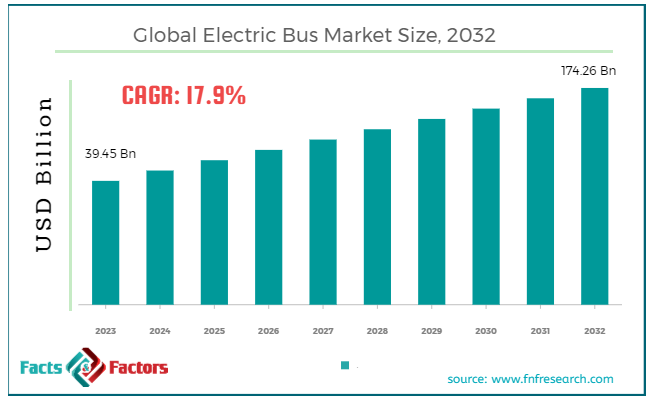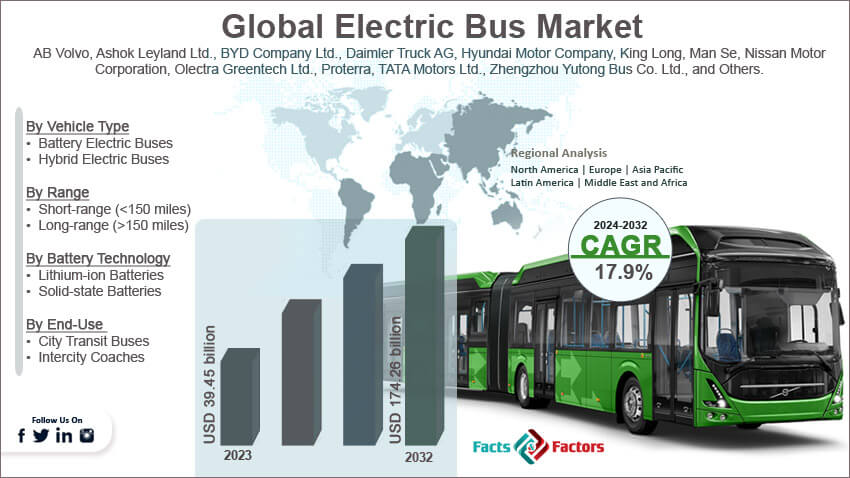 en
en  en
en  en
en  en
en 
[219+ Pages Report]According to Facts & Factors, the global electric bus market size in terms of revenue was valued at around USD 39.45 billion in 2023 and is expected to reach a value of USD 174.26 billion by 2032, growing at a CAGR of roughly 17.9% from 2024 to 2032. The global electric bus market is projected to grow at a significant growth rate due to several driving factors.

 Market Overview
Market OverviewAn electric bus is a type of bus that is powered by electricity, typically sourced from onboard batteries, rather than by conventional internal combustion engines that use diesel or gasoline. These buses are designed to be more environmentally friendly, as they produce zero emissions at the point of use, contributing significantly less to air pollution and greenhouse gas emissions compared to traditional buses. Electric buses rely on a variety of technologies for charging, including plug-in systems and overhead lines, and advancements in battery technology have greatly increased their range and efficiency.
Cities around the world are increasingly adopting electric buses to reduce urban pollution and meet climate goals, supported by government incentives and improvements in charging infrastructure. As a result, electric buses are becoming a common sight in public transportation networks, offering a cleaner, quieter alternative to conventional buses.
 Key Highlights
Key Highlights
 Key Growth Drivers
Key Growth Drivers Restraints
Restraints Opportunities
Opportunities Challenges
Challenges Electric Bus Market: Segmentation Analysis
Electric Bus Market: Segmentation AnalysisThe global electric bus market is segmented based on vehicle type, range, battery technology, end-user, ownership, and region.
 By Vehicle Type Insights
By Vehicle Type Insights Based on vehicle type, the global electric bus market is divided into battery electric buses and hybrid electric buses. Battery Electric Buses (BEB) solely rely on electric power, charged via external power sources. They are increasingly popular in urban centers globally due to their zero-emission nature. Governments support BEBs through incentives, leading to a significant market presence. Their adoption is spurred by advancing battery technologies that reduce costs and increase range, contributing to a robust CAGR. Hybrid Electric Buses (HEB) combine traditional internal combustion engines with electric propulsion systems.
They are particularly favored in regions where electric infrastructure is limited or as a transitional technology. The flexibility in fuel use reduces reliance on a single energy source, which can be beneficial in areas with unstable electric supply. The segment's growth is moderate, reflecting the global push towards fully electric solutions.
 By Range Insights
By Range InsightsOn the basis of Range, the global electric bus market is bifurcated into short-range (<150 miles) and long-range (>150 miles). Short-range electric buses are designed for dense urban environments where routes are shorter but stop frequency is high. They are ideal for cities committed to reducing local air pollution and traffic congestion.
The segment benefits from lower initial costs and reduced range anxiety among operators. Long-range buses cater to regional and long-distance travel, equipped with high-capacity batteries to handle extended ranges without frequent recharging. Technological innovations in battery life and fast charging capabilities are making long-range electric buses more viable and appealing. This segment is poised for growth as infrastructure develops and range concerns are mitigated.
 By Battery Technology Insights
By Battery Technology InsightsBased on Battery Technology, the global electric bus market is categorized into lithium-ion batteries and solid-state batteries. Lithium-ion batteries are the most popular choice due to their high energy density and decreasing cost. Lithium-ion batteries are expected to continue leading, with a robust CAGR. Solid-state batteries are still in developmental stages, they promise higher energy density and safety. They represent a potential future growth segment.
 By End-Use Insights
By End-Use InsightsBased on End-Use, the global electric bus market is divided into city transit buses and intercity coaches. City transit buses are the backbone of public transport in urban areas and city transit buses are pivotal in reducing urban air pollution. Transitioning to electric city buses not only helps in cutting down greenhouse gas emissions but also reduces noise pollution, enhancing the quality of urban life. The market for electric intercity coaches is expanding as battery technology advances although they are slower to adopt electric technologies. These coaches are increasingly seen as a viable option for reducing emissions on longer journeys.
 By Ownership Insights
By Ownership InsightsOn the basis of ownership, the global electric bus market is bifurcated into public and private. The majority of electric buses are owned by public transport authorities, and influenced by government policies and subsidies. The private segment includes private transit companies and corporations. This segment is expanding as corporate responsibility and sustainability become more important.
 Recent Developments:
Recent Developments: Report Scope
Report ScopeReport Attribute |
Details |
Market Size in 2023 |
USD 39.45 Billion |
Projected Market Size in 2032 |
USD 174.26 Billion |
CAGR Growth Rate |
17.9% CAGR |
Base Year |
2023 |
Forecast Years |
2024-2032 |
Key Market Players |
AB Volvo, Ashok Leyland Ltd., BYD Company Ltd., Daimler Truck AG, Hyundai Motor Company, King Long, Man Se, Nissan Motor Corporation, Olectra Greentech Ltd., Proterra, TATA Motors Ltd., Zhengzhou Yutong Bus Co. Ltd., and Others. |
Key Segment |
By Vehicle Type, By Range, By Battery Technology, By End-Use, By Ownership, and By Region |
Major Regions Covered |
North America, Europe, Asia Pacific, Latin America, and the Middle East &, Africa |
Purchase Options |
Request customized purchase options to meet your research needs. Explore purchase options |
 Electric Bus Market: Regional Analysis
Electric Bus Market: Regional AnalysisAsia-Pacific holds a dominant position in the global electric bus market, primarily due to China's massive deployment of electric buses. The region’s CAGR is estimated at over 34.7%, driven by large-scale deployments and continuous innovations in battery technology. Other countries like India, Japan, and South Korea are also expanding their fleets of electric buses.
China is the undisputed leader within APAC, driven by stringent air quality regulations, ambitious national sales targets for electric vehicles, and substantial government subsidies that have fueled the Chinese electric bus market. China boasts a robust domestic electric bus manufacturing industry with major players like BYD, Yutong, and Sunwin. These companies benefit from economies of scale and technological advancements.
North America is experiencing significant growth in the electric bus market, driven by stringent emissions regulations and increasing government support through incentives and funding for electric vehicles. The U.S. and Canada are actively promoting the adoption of electric buses in public transportation fleets.
The presence of major electric bus manufacturers and technology companies supports the market growth. Initiatives such as the Low or No Emission Vehicle Program by the Federal Transit Administration enhance the deployment of electric buses. The electric bus market in North America is projected to grow at a CAGR of approximately 25.89% over the next five years.
Europe leads in the electric bus market due to early adoption encouraged by government policies aiming for a reduction in carbon footprints and the promotion of electric vehicles as a part of public transport systems. High fuel prices, strong regulatory frameworks, and well-established public transportation infrastructure significantly contribute to the growth. Countries like Germany, the UK, and France are front runners in the market. The projected CAGR for the European electric bus market is around 31.8% through the forecast period, reflecting aggressive policies toward decarbonization.
The market in Latin America is emerging with countries like Brazil and Mexico beginning to adopt electric buses, particularly in densely populated urban areas. Increasing awareness of environmental issues, coupled with government support for sustainable transport solutions, drives the market. With ongoing projects and government support, the CAGR is expected to be around 20.25% over the next decade.
The Middle East & Africa region is slowly adopting electric buses, with initiatives in countries such as South Africa and the United Arab Emirates. The market growth is primarily due to the increasing investment in smart cities and sustainable public transport solutions by governments. The growth rate is projected to be around 15.21%, influenced by gradual policy shifts towards green energy and sustainable transport.
 Electric Bus Market: Competitive Landscape
Electric Bus Market: Competitive LandscapeSome of the main competitors dominating the global electric bus market include;
The global electric bus market is segmented as follows:
 By Vehicle Type Segment Analysis
By Vehicle Type Segment Analysis By Range Segment Analysis
By Range Segment Analysis By Battery Technology Segment Analysis
By Battery Technology Segment Analysis By End-Use Segment Analysis
By End-Use Segment Analysis By Ownership Segment Analysis
By Ownership Segment Analysis By Regional Segment Analysis
By Regional Segment Analysis

Copyright © 2024 - 2025, All Rights Reserved, Facts and Factors
 en
en  en
en